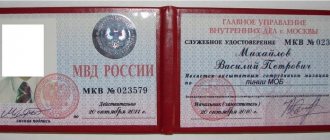Insurance is a system that is aimed at protecting the property values of individuals and legal entities. Such a need is necessary in the event of a threat to the existence of interests of a material nature. This is why the need for an insurance product in the financial market is so great and understandable.
Several points characterizing the insurance product should be highlighted:
- a certain type of object (what is subject to insurance);
- the presence of main factors for registration (possible circumstances that could cause material harm);
- insurance risk analysis (calculation of the probability of an event occurring, the amount of possible damage);
- sum insured (cost determination);
- insurance tariff (price of this product);
- calculation of conditions for making financial payments.
Product registration is recorded by a special document - an insurance policy. This certificate confirms the conclusion of an agreement for the provision of insurance services between the organization and the interested citizen.
In addition to compulsory insurance in the Russian Federation, there is great interest in this type of service as non-state pension insurance. It is carried out on a voluntary basis in addition to mandatory. This type of insurance appeared on the territory of the Russian Federation in 2002.
The essence of the mechanism and system of insurance of non-state pension funds as a whole
Public pension funds represent special non-profit social security institutions. Their main structure includes the implementation of public services for the population. The main purpose of such an organization is pension compensation for individuals who have overcome the established age threshold.
The possibility of this insurance is available to every interested person. When applying non-forcedly to a non-governmental organization, it is enough to draw up a contract for receiving pension insurance, which is drawn up with the participation of the organization and the insuring party, and is signed bilaterally. Registration of this insurance, like state insurance, is confirmed by the presence of an insurance policy.
The structure of non-state pension insurance has some features:
- the presence of pension accruals is carried out even in the absence of official work experience for the insured person, while in the state fund the appropriate length of service worked by the citizen in official employment is required;
- Such an insurance system provides an independent choice of organization and paperwork for any adult resident of the country.
The government approved a bill to change the rules for paying private pensions
Currently, citizens of retirement age can receive payments from non-state pension funds. If a person entered into an agreement with a non-state pension fund before January 1, 2021, then he can receive payments upon reaching 55 years of age for women and 60 years of age for men. If the contract is concluded after this, you must wait until the legal retirement age according to the new rules.
This significantly undermined the popularity of NPFs. Therefore, a bill has been submitted to the Government to amend these rules so that citizens can in any case receive a private pension under the old laws, i.e. during the pre-retirement period of his life.
In addition, the bill contains proposals to exclude the need for insurance coverage from the requirements for receiving a private pension, and to supplement the guarantees of receipt for the disabled and other categories of the population entitled to early retirement.
The bill has received full approval and will be considered at the autumn session of the State Duma of the Russian Federation to obtain the status of law.
Features of the functioning of the system of non-state pension funds
Pension insurance can be provided with any fund: state or commercial. The final choice depends on the citizen who decides to seek services.
When insuring pension contributions in non-state organizations, you should pay attention to the fact that they are insurers of the funded component of the entire amount of the labor pension.
Based on the results of the transformations completed in 2013, there are three alternatives for managing funded pension funds:
- when transferring from the Pension Fund of Russia to a non-governmental organization, there is an opportunity not to undertake any activity, which allows you to keep your savings intact;
- the possibility of voluntary transfer of pensions through the use of a compulsory insurance program through the execution of a contract;
- After the accumulation time has elapsed, in accordance with rising inflation, the amount of funds increases, which indicates their mandatory investment.
Which is better: NPF or Pension Fund?
We have already mentioned that from 2002 to 2014, within the framework of the compulsory pension system, a pension was formed, consisting of two parts: insurance and funded. Despite the fact that there is now a moratorium on the formation of funded pensions, what they managed to accumulate before 2014 has not gone away. Citizens strive to properly manage their savings portion, so they are interested in the question of who to entrust the management of this money to the Pension Fund or Non-State Pension Fund?
REFERENCE: Citizens have the right to choose where to keep and form a funded pension in a non-state pension fund or Pension Fund.
| Advantages | Flaws | |
| Pension Fund |
| The investment policy is aimed at minimizing risk, so you should not expect to receive a high income by saving funds in the Pension Fund. |
| NPF |
|
|
Thus, when choosing between the Pension Fund and the Non-State Pension Fund, a citizen chooses between reliability and stability and the opportunity to receive a high income. The Pension Fund guarantees the safety of funds and protection from inflation, but you should not expect a significant increase in the funded pension by choosing the Pension Fund.
A private foundation, with proper management of the client’s funds, will be able to significantly increase them. However, profits can be lost if the NPF goes bankrupt, loses its license or pursues an illiterate financial policy. Therefore, when giving preference to non-state pension funds, you should carefully choose the organization to which you entrust your money.
Interaction of two types of non-state pension insurance
The system of pension organizations of the Russian Federation represents an independent functioning segment of the economic department of the state. This mechanism regulates and provides compensation to citizens using redistributed savings.
Monthly payments for several categories of citizens are one of the main activities of the Pension Fund. Military personnel, disabled people, elderly people, large and single-parent families, citizens with income below the established subsistence level receive monthly pensions, as well as social benefits.
It is worth noting that these types of insurance have their advantages and disadvantages. Among the positive qualities of state pension insurance, the following should be highlighted:
- the likelihood of increasing your pension amount using accumulative (savings) funds;
- eliminating the possibility of closure or disappearance of a fund under state supervision. This provides a greater guarantee of safety and preservation of accumulated savings.
Non-state pension insurance has its positive aspects:
- regular reporting of all deposits received to the personal account of the insured person;
- individual work with each interested customer;
- the ability to dispose of savings before the age prescribed by the state;
- ensuring an additional state of accumulated funds;
- the opportunity to invest savings in the country's stock market.
Pension funds, government and non-profit organizations, have a number of advantages and disadvantages. Making a single right decision is a rather complex and difficult process.
Thus, the final choice for pension insurance should be made after a thorough analysis of the activities of the entire structure of the selected funds and a detailed comparison of the results obtained.
Is it possible to change a non-state pension fund?
As we have already said, an agreement with a private pension fund is not a lifetime contract. A person may want to change the NPF if he has lost faith in its investment policy or reliability. The fund responsible for the funded part of the compulsory pension pension can be changed at least every year. The algorithm is the same as when transferring from the Pension Fund to the Non-State Pension Fund (see previous paragraph).
The transition from one NPF to another within the framework of a voluntary NGO is regulated by an agreement between the organization and the citizen. The conditions of such a transition (termination of the contract) must be spelled out in detail in it.
According to the terms of the agreement, it may turn out that during the transition a person will be left without investment income for some time or for the entire period, and sometimes even go into losses (receive less than he contributed). This is explained by the fact that contracts with non-state pension funds are designed for the long term - the funds invest citizens’ funds in long-term projects with high returns. By withdrawing funds from the NPF before the end of the contract, the fund incurs losses. Therefore, the person’s money will be returned, but it’s not a fact that everything will be returned.
Current issues about non-state pensions and non-state pension funds
What is a non-state pension and who receives it?
The main difference from standard state support: you do not need to have a certain length of service in order to receive payments in the future. The amount will depend only on the contributions made; the pension is assigned regardless of the age established for retirement. But now only citizens who have entered into an agreement with a non-state pension fund before January 1, 2021 receive this right. They can count on payments under the old scheme, which existed before the retirement age was raised. Women can receive such a pension from the age of 55 (as before), men - from the age of 60.
Persons who enter into an agreement with a non-state pension fund in 2021 and later do not have such a privilege, in accordance with current legislation. They will begin to receive a non-state pension simultaneously with the state pension.
How to receive a non-state pension?
Investors of the above-mentioned non-state pension funds have the right to receive. In the period from 2008 to 2015, working citizens could send part of their monthly contributions to the Pension Fund (PFR) not only for the formation of a future insurance pension, but also to the NPF. The employer transferred 22% of insurance contributions to the Pension Fund for each employee according to the general rule, but until 2015, a citizen could independently choose a non-state pension fund and enter into an agreement with it. In this case, part of the contributions (16%) was sent to the Pension Fund for the formation of a future state pension, and 6% went to the NPF.
A pension in a non-state pension fund is accumulated mainly through investing in securities. The law stipulates that NPFs are required to organize a risk management system, undergo stress testing of financial stability, etc. Accordingly, funds cannot use assets with high risks; as a rule, NPFs invest in government securities and bonds. The income received is distributed among the accounts of future retirees and increases the size of their pension.
The law is also aimed at combating the risks of unsuccessful investments. In 2018, Federal Law No. 49-FZ dated March 7, 2018 amended the regulation of the activities of non-state pension funds; funds now have the obligation to independently compensate losses to investors. If it is confirmed that the NPF did not act in the interests of future pensioners, deliberately invested money in low-quality assets, as a result of which clients lost part of their funds, then it is the NPF that must compensate for these losses and return the lost money to people.
Despite all the strict regulation of the activities of non-state pension funds, private pensions have not become popular in Russia. Starting from 2015, contributions of working citizens (6%) to NPFs were frozen. Today, you can only make additional contributions to non-state funds yourself. According to statistics, very few people do this, preferring to invest and manage money on their own.
Increasing pensions for military pensioners from October 1, 2021 - what is important to know?
How accumulated funds are paid to NPFs
To assign a non-state pension, you must submit an application to representatives of the relevant institution. The list of specific supplementary documents differs depending on where a particular citizen is served.
The non-state payment is assigned on the same day the citizen applies for it. Transfer of money begins a maximum of 30 days after the first request.
As for the size of the future pension, it is determined by several factors:
- The amount accumulated at the time of registration of the pension.
- The pension scheme specified in the contract.
- Rules of the selected fund.
If at the end of the year the institution managed to receive a higher income, this means that the amount of security for the citizen increases.
When the amount has been determined, the citizen is sent a corresponding notification. The document lists not only the amount, but also the deadlines for payment of compensation.
To transfer funds use one of the following methods:
- Postal transfer.
- Bank card with a specific number.
- Bank account number.
Attention! In a written appeal to a citizen, all necessary information is indicated. If a client's personal information changes, he must notify those with whom he interacts about this.










